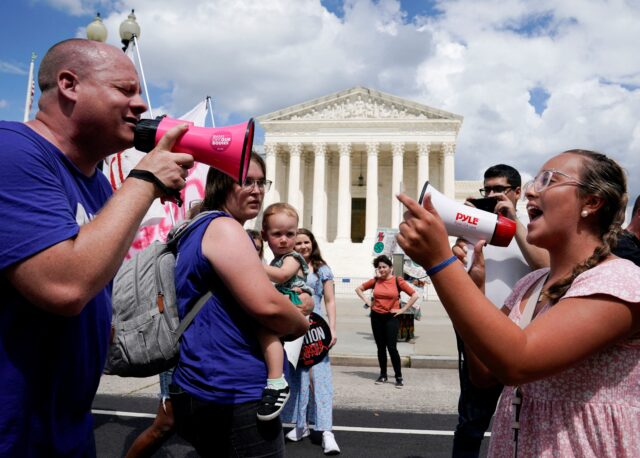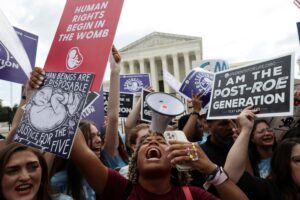
Georgette Forney still remembers when, at 16 years old, she sought an abortion.
“I kept thinking, ‘I don’t want to embarrass my family,'” the co-founder of Silent No More Awareness Campaign and president of Anglicans for Life said. “I also kept thinking, ‘I can’t have a baby. A baby threatens my future, my plans.'”
She wanted to go to college. Get married. And a baby, she thought, threatened that.
“Instead of saying, ‘Wow, women are strong and we can do whatever needs to get done’ — which is how I look at it now — I thought, ‘I can’t handle both. I can’t handle school and a baby,'” she described her abortion in 1976.
Forney, along with other leaders and experts, spoke with Our Sunday Visitor newspaper after the Guttmacher Institute, a reproductive research organization that supports abortion, estimated earlier this year that the number of abortions is the highest it has been in over a decade.
The increase came as a surprise: A growing number of state pro-life protections for the unborn limit abortion following the Supreme Court’s decision in Dobbs v. Jackson Women’s Health Organization. The decision, handed down on June 24, 2022, overturned the court’s 1973 ruling in Roe v. Wade that previously legalized abortion nationwide, freeing individual states to decide abortion policy.
Leaders of national pro-life organizations addressed reasons for the increase and shared their responses, while emphasizing that even one abortion is too many. They pointed to pregnancy centers and maternity homes as a solution — one that empowers women to choose life for their babies.
Networks of pregnancy centers revealed that, while Guttmacher estimates an increase, they also see an increase in women turning to them for help. Women are seeking abortions now, they said, for the same reasons they did before Dobbs.
First and foremost, they wanted pregnant and parenting women to know: You are not alone, and we are here to help you.
For her part, Forney openly shares her story, which she now calls God’s story. She regrets her choice — one that she has testified before Congress about — and has since dedicated her life to saving lives. That includes her work with the Silent No More Awareness Campaign, which represents more than 21,000 people wounded by abortion.

Today, when she encounters a woman considering an abortion, she likes to ask the question: “Why do you think abortion is the best choice for you?”
“Until we understand ‘the why’ behind what she’s seeking, we can’t help her,” she said. “But, you ask the question, you have to be ready for the answer, right?”
An estimated 1,037,000 abortions took place in the formal health-care system in 2023 — the first full calendar year after the Dobbs decision — according to Guttmacher’s “Monthly Abortion Provision Study.”
That number translates to a rate of 15.9 abortions per 1,000 women of reproductive age and an 11% increase since 2020, the last year with comprehensive estimates available, according to a Guttmacher policy analysis.
These numbers — which combine data from abortion providers with statistical modeling — are likely higher, according to Guttmacher, which does not count abortions outside the formal health care system.
Guttmacher’s policy analysis explored possible reasons behind the increase, beginning with new efforts to increase abortion access for women in states with pro-life laws.
The states that ban abortion have been “counterbalanced by monumental efforts on the part of clinics, abortion funds and logistical support organizations to help people in ban states access care through financial and practical support,” the analysis reads.
It also suggests abortion access improved for women who live in states that don’t restrict abortion. The analysis listed potential factors, including broader availability of telehealth for abortion pills, increased financial support — particularly from abortion funds — and state policies that protect abortion.
Several pro-life leaders pointed to easier access to the abortion pill as helping drive the overall increase. Among its findings, Guttmacher’s study estimated that abortion pills made up 63% of U.S. abortions in 2023, an increase from 53% in 2020.
“I think a really important element to take into account is the use of abortion drugs and how high the usage is,” Anna Callahan, communications director for Susan B. Anthony Pro-Life America, said.
The U.S. Food and Drug Administration first approved the drug mifepristone, which is paired with another drug, misoprostol, for earlier abortions in 2000. Currently permitted for use through 10 weeks gestation, this type of abortion is also called the abortion pill, chemical abortion, medication abortion or telemedicine abortion.
A brief led by SBA Pro-Life America in a case concerning the abortion pill mifepristone argued earlier this year before the Supreme Court asked the court to affirm the U.S. Court of Appeals for the Fifth Circuit. The Fifth Circuit ruled last year to sustain the FDA’s initial approval of mifepristone while rejecting the federal agency’s more recent decision to lift regulations that prohibited mailing the drug and prescribing it by telemedicine, among other things. The brief argued that the FDA’s current protocol not only makes informed consent about risks impossible but also endangers women.
Katie Daniel, state policy director for SBA Pro-Life America, called it “a sad day for all who value women’s health and unborn children’s lives, but the fight to stop dangerous mail-order abortion drugs is not over.
In their interviews with Our Sunday Visitor, several pro-life leaders, while addressing the increase in abortions, questioned the numbers available on abortion, particularly with the abortion pill. Some said that just because pills are distributed doesn’t mean women ingested them. Others pointed out the difficulty in tracking drugs sent in the mail.
Still others said that women may have tried to reverse the effects of the abortion pill in what’s known as “abortion pill reversal.” The process attempts to overcome the effects of mifepristone, which blocks the hormone progesterone, by giving women more progesterone.
These estimates, some said, are just that: estimates.
At Students for Life of America and Students for Life Action, Kristi Hamrick, vice president of media and policy, highlighted that following Dobbs more children were born. According to an analysis published by the Institute of Labor Economics, an estimated 32,000 more babies were born annually due to pro-life laws enacted after Dobbs.
Other pro-life leaders looked beyond the numbers.
“Regardless of the current legal landscape, one abortion is too many and we hope that no woman or child ever has to experience the pain and suffering caused by it,” March for Life President Jeanne Mancini stressed.
To empower women, Lauren Muzyka, president and CEO of Sidewalk Advocates for Life, which works to train, equip and support communities in sidewalk advocacy outside of abortion clinics, emphasized responding to why they seek abortions.
“Our role is to uncover the woman’s reason for seeking abortion and to provide her with the support and resources she needs to deal with her actual problem,” Muzyka said. “When we are able to help that woman deal with the issue that truly is the problem, she can see that her pregnancy is not the problem — and she can freely choose life for her child.”
Earlier this year, a piece published in Science Advances, “The ‘abortion imaginary’: Shared perceptions and personal representations among everyday Americans,” examined Americans’ perceptions of abortion. The piece, led by sociologist Tricia C. Bruce, states that most women seek abortion for financial reasons.
“In addition to finances, when making an abortion decision women commonly weigh factors such as pregnancy timing, their relationship with the person involved in the pregnancy, future plans and the needs of their other children,” it reads. “While 14% of abortion patients are married and about a third cohabitate with their partners, ‘bad relationships with men’ and the likelihood that a ‘new baby would derail life plans and career goals’ commonly factor into abortion decisions.”
“A sizable minority seek an abortion because they want ‘to be good moms to their existing children,'” it adds. “While some abortion patients have completed their childbearing or do not want children, almost 40% want children in the future.”
The piece referenced other studies, including “Understanding why women seek abortions in the US” published in BMC Women’s Health in 2013. It found women’s reasons fell into 11 themes.
“The predominant themes identified as reasons for seeking abortion included financial reasons (40%), timing (36%), partner-related reasons (31%) and the need to focus on other children (29%),” it reads. “Most women reported multiple reasons for seeking an abortion crossing over several themes (64%).”
Bruce and her co-authors also found a disconnect between the women who get abortions and who Americans think get abortions.
“There are some things that Americans are correct — or closer to correct — about in their guesses about who seeks abortions and why, and others where they’re off,” Bruce said.
She gave an example of where perceptions are more correct: Thinking that finances matter. While women who seek abortions might cite a multitude of reasons, they’ll often point to finances as the number one reason, she said.
An example of where perceptions and reality are farther apart, she added, is “this idea of motherhood.”
“If you look at who gets abortions in the United States, the majority of women are already mothers,” she said, referencing her piece that cites that 60% of women getting abortions have other children.
“What that means is that women are not necessarily in a position of deciding whether or not to parent or whether or not to be a mother, but, in fact, they’re deciding whether or not to parent again and to be a mother again,” she said.
She addressed the importance of perceptions and reality matching.
“As Americans, we tend to live our lives in oftentimes a filtered way in the sense that what we’re surrounded by [is] other people who share similarities to us both in terms of class, race, perhaps values or otherwise — and that can be really advantageous because we feel like we have a sense of community,” she said. “But the disadvantages, I think, come out in places like this, where we’re unable to imagine someone else’s situation.”
She added: “That can become a roadblock in being able to sort of foster productive conversations around this kind of issue, which has such broad implications for U.S. life and law today.”
At Charlotte Lozier Institute, or CLI, the research arm of SBA Pro-Life America, researchers said that a majority of women would prefer to keep their babies with more support.
“A recent CLI analysis of state data shows that over 95% of abortions are for elective (which includes emotional and financial) reasons,” Senior Research Associate Tessa Longbons Cox and Research Associate Mia Steupert said. “Other CLI research shows that 60% of women would have preferred to have their babies if they had received more emotional support or had more financial security.”
They called pregnancy centers and other life-affirming assistance critical because “when women receive love and support, lives are saved.”
“More than 2,750 pregnancy centers nationwide provide $367 million in goods and services every year, with the vast majority of those goods and services provided free of charge,” they said, citing a CLI report. “These pregnancy centers are estimated to have saved 800,000 lives in a recent five-year period.”
Networks of pregnancy centers that directly minister to pregnant and parenting women in need said they see women seeking abortions now for the same reasons as before Dobbs.
“I think the heart of it all does still remain,” Andrea Trudden, vice president of communications and marketing at Heartbeat International, which includes a network of more than 3,000 pregnancy help organizations, said. “They’re scared and they’re nervous.”
Her group manages Option Line, a 24/7 pregnancy helpline, which hears around 1,100 stories daily from women and men.
“They’re contacting us because they’re caught up in the moment, they’re either just graduating school or they already have children and are concerned about finances,” she said.
As president and CEO of Care Net, a nonprofit that supports a network of 1,200 pregnancy centers, Roland Warren shared what they see driving women toward abortion.
“Most often, it is the same reason they visited a pregnancy center before Dobbs: their perception that they have missing support for their child,” he said. “And this is most often linked to the fact that the father of the unborn child is unable or unwilling to provide the support that the mother and child need.”
He also called the wider availability of the abortion pill “a common post-Dobbs factor” that shortens the window to reach clients and makes them more desperate for help.
Pregnancy centers are also seeing more people turning to them for support. Trudden pointed to two recent reports that show increases, her organization’s 2024 “Life Trends” report and a CLI report, “Hope for a New Generation.”
“The suspicion at this point, really, is the fact that people are talking about pregnancy centers more over the past couple of years,” she said.
They are seeing an increase in clients overall, as well as an expansion of services within their pregnancy help organizations, she said. At Heartbeat International, which manages the Abortion Pill Rescue Network, that includes pregnancy centers that are expanding to include abortion pill reversal.
At Care Net, Warren said that, overall, their network is busier than before Dobbs.
“Some centers are seeing more clients, and others, while they may be seeing the same number of clients, are facing more challenging work due to the shifting legislative climate and changes in the availability of the abortion pill,” he said.
CLI’s report notes that the over $367 million in goods and services provided by over 2,750 pregnancy centers in 2022 represents a more than $100 million increase since 2019.
The economy, Trudden said, plays a role in women seeking support from pregnancy centers because their services are free.
“Once we have the conversations with the women — if we talk to them about their vision for their future, what goals they have and what challenges they see — and then actually help them figure out a plan … just like before Dobbs, they build up confidence,” she said.
National pro-life organizations are responding to the increase in abortion by continuing their work to protect the dignity and worth of every human person, particularly that of the unborn.
“No matter how many lives are ended by abortion, our work remains the same — to protect life in law and in service,” Hamrick at Students for Life said.
At SBA Pro-Life America, Callahan said they are working to shape pro-life policy in the states and federal government. Among other things, they want to hold the FDA accountable on the abortion pill, as well as support pro-life safety net legislation.
“We think it’s critical to the pro-life movement to support women at a federal level,” she said, voicing support for congressional bill, including the Providing for Life Act, the HOPE Act and the MOMS Act.
Some highlighted efforts to directly empower pregnant and parenting women. As president of Feminists for Life, Serrin Foster pointed to their help site, WomenDeserveBetter.com, which provides information on a variety of issues, from work and home life to education and relationships.
Kat Talalas, assistant director for pro-life communications at the U.S. Conference of Catholic Bishops’ Secretariat of Pro-Life Activities, shared the bishops’ response. Most recently, they launched a nationwide prayer initiative leading up to the Supreme Court ruling determining the future availability of the abortion pill.
She stressed the many services available within the Church, from Catholic Charities and Catholic hospitals to the Sisters of Life, who serve women vulnerable to abortion, and Project Rachel Ministry, for those wounded by abortion.
Talalas encouraged Catholics to participate in the bishops’ nationwide parish-based initiative, Walking with Moms in Need, which works to ensure that any woman unexpectedly pregnant or parenting small children in difficult circumstances can turn to their local Catholic church.
“We want everyone to know — people in and outside the pews — the church is here for moms in need,” she said.
Pro-life groups and pregnancy center networks saw the estimated increase in abortion as a call to action for every pro-life person.
“It will take all of us, one person at a time, to show the kind of love and support that makes abortion unthinkable and unavailable,” Hamrick at Students for Life said.
Leaders encouraged supporting pregnancy centers and maternity homes. Some asked people of faith to pray and called on citizens to vote pro-life. Others wanted pro-life Americans to be aware of nearby help so that they could direct women in need.
At Heartbeat International, Trudden recommended people type in their zip code at OptionLine.org to find the closest pregnancy help.
Warren, at Care Net, called on pro-life Americans to see the increase as an opportunity to become “Pro Abundant Life” or “focused on God’s design for family and God’s call to discipleship.”
He encouraged people to mobilize their churches. They should also educate and equip themselves to transform hearts and minds, beginning in their churches, he said, highlighting that 54% of women who have abortions identify as Catholic or Protestant.
Callahan at SBA Pro-Life America and Hamrick at Students for Life stressed the importance of voting. Hamrick pointed to her group’s “Pro-Life Generation Report Card” to hold politicians accountable.
Forney shared her advice for engaging women seeking abortion: “We can’t talk at them. We have to listen to them.”
She spoke from personal experience. Forney revealed that she once opened up her home to a young pregnant woman who wanted an abortion. That woman ended up choosing life, giving birth on Thanksgiving — and placing her baby for adoption.
She recently connected with the adoptive family and planned to visit her.
“That, to me,” Forney said, “is a story of hope and redemption.”









